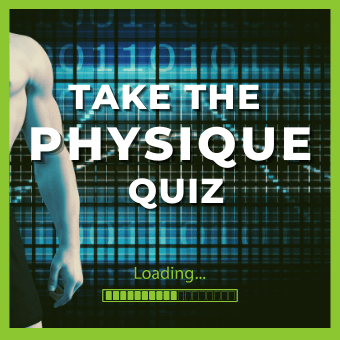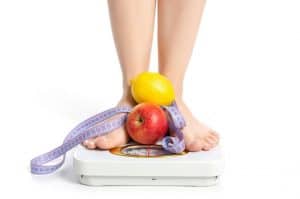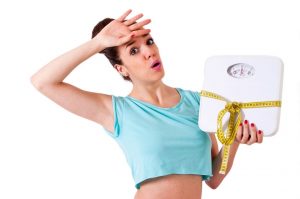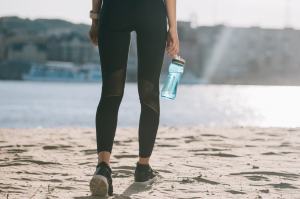If you are new to yoga, it is only normal to find it challenging and intimidating. This is especially true if you do not have any idea how to start.
This guide can help you with the yoga exercises you can do as a beginner. So, before trying any yoga for flexibility for beginners, we recommend you check out this guide first.
Let’s get started.
Effective Flexibility-Boosting Yoga Poses for Beginners
Downward-Facing Dog
- Begin with your hands and knees. Stack your hands under your shoulders, then stack your knees underneath your hips.
- Widely spread your hands and put pressure onto your index finger and thumb on your mat.
- Raise your tailbone and hold your butt up and back. Draw your hips facing the ceiling.
- Straighten up your legs and gently press your heels against the floor.
- The position of your head should be between your arms and towards your knees. Your back should be flat.
- Maintain this position for 5 to 10 breaths.
Mountain Pose
- Begin by standing with your toes intact and your heels somewhat apart.
- Extend your toes and evenly put weight on both feet.
- To activate your core, tuck your hips a little so that your tailbone is pointing downwards.
- Make your shoulders relax and move them backward and downwards.
- Take a deep breath and reach your arms over your head and press your feet down at the same time. You can also place your hands in a prayer position in front of your chest or relax them on the side. These are common mountain yoga pose variations, so you can pick one.
- Take slow, deep, and long breaths from your nose.
- Maintain this position for 3 to 15 breaths.
Crescent Lunge
- To begin in a staggered stance, use your left foot to take a big step forward. Your feet are about mat-length apart.
- Bend your front knee, straighten your back leg, and lift your heel from the floor.
- Try to position your thigh parallel to the surface by bending your front leg.
- Balance your hips facing the front.
- Spread your arms toward the ceiling on one side of your head. Extend up while you press the mat and feel your hips stretching.
- Maintain this position for 5 breaths. Then, do the same thing on the opposite side.
Warrior II
- To begin in a staggered stance, use your left foot to take a big step forward. Your feet should be about mat-length apart.
- Spread your arms to make them parallel to the surface.
- Flex your left knee to make it at or almost 90 degrees and your thigh is parallel to the surface. Do this while maintaining your right leg at a straight position.
- Point your left toes in front and move your right foot out to your right. This is to make your left foot perpendicular. Your left heel must be aligned to your right foot’s arch.
- Twist your torso to the right simultaneously. Your left hip should be facing the front, and your right hip is facing at the back. Your head and left arm need to be pointing forward and your right arm pointing at the back.
- Maintain this position for 1 to 5 breaths.
Triangle
- Begin this yoga pose by doing Warrior II.
- Make your front leg straight and use your left hand to reach forward and toward the floor.
- Lurch your torso forward and turn it open on your right.
- Move your arms to 6 and 12 o’clock positions.
- Put your left hand over your shin or the surface if possible. Extend the fingers of your top arm going to the ceiling.
- Maintain this position for 5 to 10 breaths. Then, do it on the opposite side.
Plank
- Start by positioning yourself on all fours. Your knees should be underneath your hips and your hands are flat on the surface and directly under your shoulders.
- Raise your knees and stretch your legs from behind. Now, you are on your hands and toes and your body has formed a long line.
- Hold your palms flatly on the surface, and your hands and shoulders should be a width far from each other. Your shoulders are directly stacked over your wrists and your core is engaged.
- Your neck and spine should be in a neutral position.
- Maintain this position for 3 to 5 breaths.
Low Plank
- Begin this by doing the plank yoga pose and placing your palms flatly on the surface. Your hands and shoulders need to be wide apart, your core is active, and your shoulders directly over your wrists.
- Then, move gradually to a low plank position. To do this, you need to flex your elbows and keep them close to the side of your body. Do so until a 90-degree angle is formed.
- Maintain this position for 1 breath.
Tree
- Begin by doing a mountain pose with your heels a little far away from each other and your toes intact.
- Move your right foot so it reaches the inner thigh of your left leg. Squeeze your inner thigh and foot together.
- Your knee at your right leg ought to be turned out and your right thigh facing the floor at 45 degrees.
- Once you can balance yourself, raise your hands and put them in a prayer position over your head or in front of your chest.
- To keep your balance, concentrate on looking at a fixed point towards you.
- Maintain this position for 5 to 10 breaths. Then, do it on the opposite side.
Dancers
- Stand tall and keep your feet close.
- Flex your left knee and move your left foot toward your buttocks.
- Using your left hand, take hold of your left foot’s inner arch and gradually raise your foot toward the ceiling. Stretch your right arm forward and toward the ceiling at the same time.
- Use your entire right foot to press down into the surface as you open your chest and pull up your raised leg.
- Maintain your chest raised.
- Maintain this position for 5 to 10 breaths. Then, do it on the opposite side.
Frequently Asked Questions About Yoga and Flexibility
What is yoga?
Put simply, yoga aims to bring balance to your mind and body. It utilizes asanas and pranayama.
Asanas are the physical aspect of yoga which are the different postures done. Meanwhile, pranayama is the breathing exercise involved in yoga. In other words, yoga is also about the study of yoga philosophy, self-reflection, and meditation.
How can I know if I’m doing yoga right?
If you are doing yoga at home without assistance from an instructor, you might worry if you are doing the yoga poses correctly or not.
Keep in mind that from the start, our body and bones are not the same. Therefore, there is no single correct way to do yoga poses. Yoga is about discovering what movements and exercises are best for the body.
How can I benefit from doing yoga?
Doing yoga can do a lot of wonders to your body. It makes you toned, strong, and flexible. Moreover, your breathing, metabolism, and energy become better. It also makes your heart healthy and develops your fitness, posture, and pain threshold.
You can also have better mental health because yoga poses can make you feel happier, calmer, and more balanced. You can manage stress better which provides you with more energy and better self-confidence.
How often should I do yoga?
You will see a difference even if you do yoga once a week. Nevertheless, if possible, do it 3 times a week. Practices as short as 10 to 20 minutes can help than not doing any yoga at all.
Should I get equipment if I will do yoga at home?
If you are just starting, you can do yoga as soon as possible without using equipment or wearing particular clothing.
As long as your clothes feel comfortable and do not limit your movement, these are okay. A yoga mat can give you cushion and prevents your hand from spilling because of the poses.
What time should I do yoga?
There is no specific time as long as you have time to do it. Doing it in the morning is significant because the body can be stiff. Therefore, doing yoga can be an energizing way to start the day. Doing it in the evening is also nice since it can provide relaxation after a long day at work.
Is it okay to eat before doing yoga?
During a session, it is better if you are not very full. Therefore, you can set aside 2 hours between a meal and yoga.
Energy is used when food is digested. Thus, if you do yoga exercises after having a meal, the energy goes into the exercise. As a result, your body will not be able to properly digest food. You can have nuts or half a banana to have energy if you become too hungry.
A Final Word From Energetic Lifestyle
Finally, you are now ready to start with yoga. There are several variations on yoga poses that are perfect for different levels of flexibility and fitness. After all, yoga is more than just movement.
The blend of movement, breathing, and meditation can improve your mental and physical well-being. Yoga for flexibility for beginners can be pretty easy to execute, regardless of limitations. Just make sure to follow our recommendations above.











